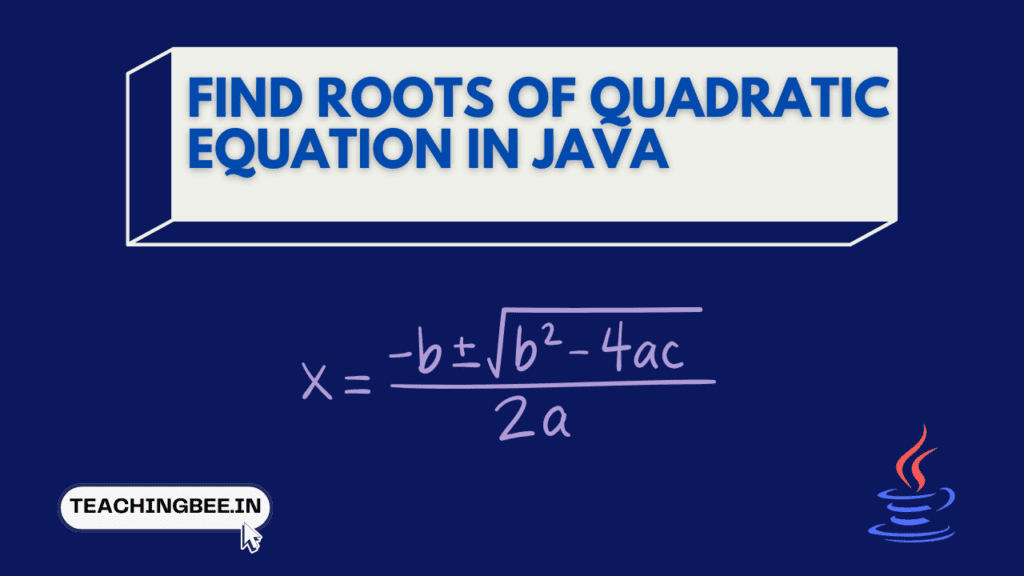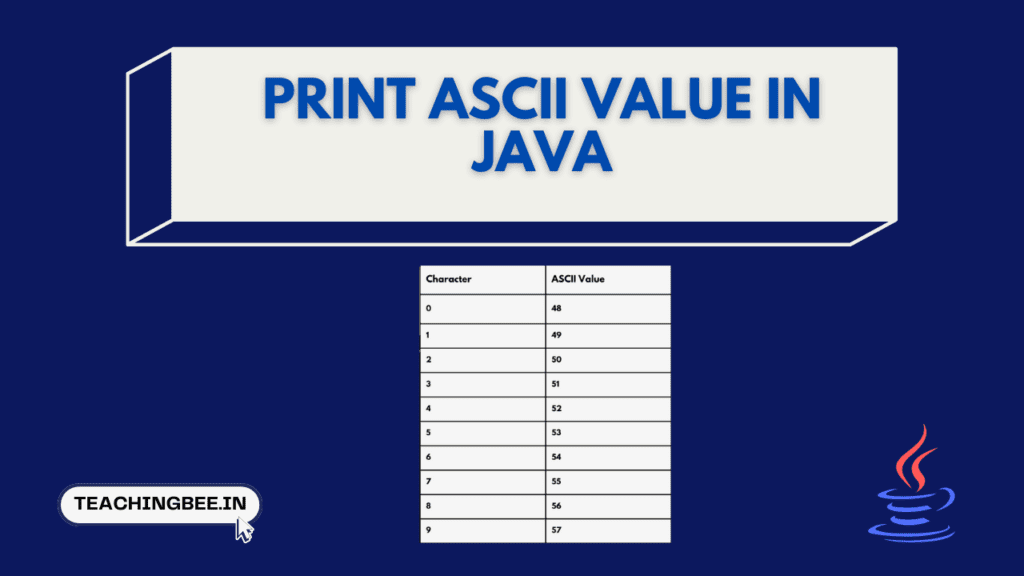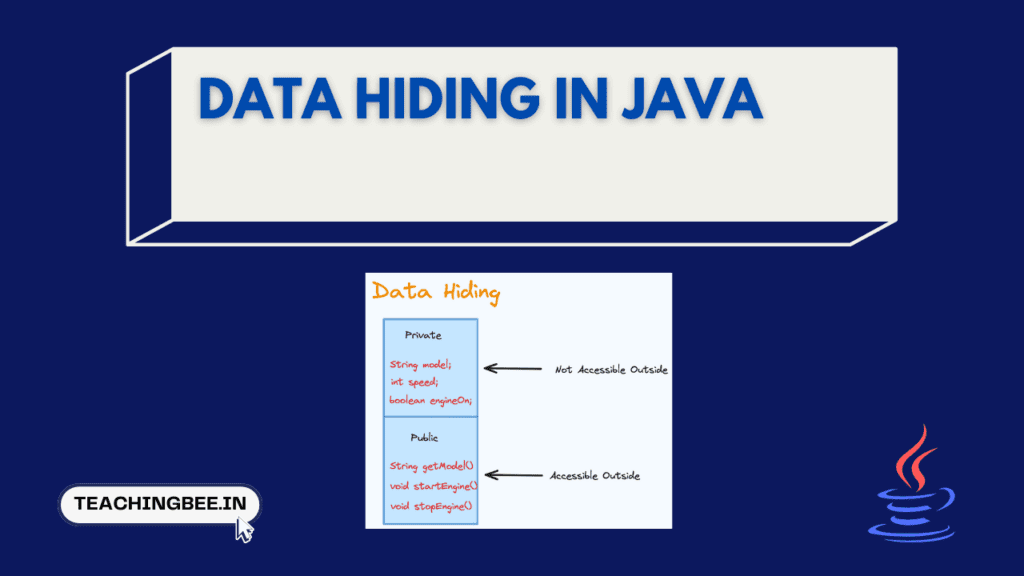Table of Contents
ToggleIn this article, we will see find roots of Quadratic Equation in Java. We will see various percentage division program in java.So, Let’s dive in.
Problem Statement
Given the coefficients a, b, and c of a quadratic equation ax^2 + bx + c = 0, write a program to find the roots of quadratic equation in Java.
For Example
Input:
a = 1
b = 5
c = 6
Output:
Root 1 = -2
Root 2 = -3Solution
Before moving towards the solution let’s first see how are the roots of quadratic equation calculated.
Calculating Roots Of Quadratic Equation
Steps to find the roots of a quadratic equation:
Step 1: Calculate the Discriminant, (D)
The discriminant of a quadratic equation is given by the formula:


Where, (a), (b), and (c) are coefficients of the quadratic equation.
The discriminant (D), helps determine the nature of the roots of the equation.
Step 2: Determine the Number of Roots based on (D)
The value of the discriminant can determine the nature and number of roots:
- If (D > 0): The quadratic equation has two distinct real roots.
- If (D = 0): The quadratic equation has exactly one real root.
- If (D < 0): The quadratic equation has no real roots which means roots are complex.
Step 3: Use the Quadratic Formula to Find the Roots
The quadratic formula is a universal method for finding the roots of a quadratic equation. The formula is:


Where:
- x are the roots of the quadratic equation.
- (D) is the discriminant.
- The ± symbol indicates that there are usually two solutions: one for the positive square root and another for the negative square root.
So, based on the quadratic formula
If (D = 0), x = -b/2a
And if (D<0), since both the roots are complex and will be of form a+ib and a-ib. Here “a” is real part of roots and “b” is imaginary part of roots. Therefore:
Real part of roots: -b/(2a)
Imaginary part of roots: sqrt(-D)/(2a)
Java Code Implementation
// Roots of quadratic equation program in java
import java.util.Scanner;
public class QuadraticEquation {
public static void main(String[] args) {
// Create Scanner object for user input
Scanner scanner = new Scanner(System.in);
// Prompt user for coefficients a, b, and c
System.out.print("Enter coefficient a: ");
double a = scanner.nextDouble();
System.out.print("Enter coefficient b: ");
double b = scanner.nextDouble();
System.out.print("Enter coefficient c: ");
double c = scanner.nextDouble();
// Step 1: Calculate the discriminant, D
double D = b * b - 4 * a * c;
// Step 2: Determine the number of roots based on D
if (D > 0) {
// Two distinct real roots
// Step 3: Use the quadratic formula
double root1 = (-b + Math.sqrt(D)) / (2 * a);
double root2 = (-b - Math.sqrt(D)) / (2 * a);
// Output the roots
System.out.println("Two distinct real roots: ");
System.out.println("Root 1 = " + root1);
System.out.println("Root 2 = " + root2);
}
else if (D == 0) {
// One real root (repeated)
// Step 3: Use the quadratic formula
double root = -b / (2 * a);
// Output the root
System.out.println("One repeated real root: ");
System.out.println("Root = " + root);
}
else {
// Two complex conjugate roots
// Real part of the root
double realPart = -b / (2 * a);
// Imaginary part of the root
double imaginaryPart = Math.sqrt(-D) / (2 * a);
// Output the roots
System.out.println("Two complex roots: ");
System.out.println("Root 1 = " + realPart + " + " + imaginaryPart + "i");
System.out.println("Root 2 = " + realPart + " - " + imaginaryPart + "i");
}
}
}
Output
Enter coefficient a: 1
Enter coefficient b: -3
Enter coefficient c: 2
Two distinct real roots:
Root 1 = 2.0
Root 2 = 1.0Code Explanation
- The program uses the
Scannerclass, to get user input for the coefficients of the quadratic equation. - First step is to calculate discriminant using the formula discussed previously
- Based on value of discriminant, whether it is greater, equal or less than 0, nature of roots are determined
- In Step 3, for each of the case, quadratic formula is used to get each of the roots.
- If D<0, the equation has two complex roots. The real and imaginary parts of these roots are computed separately and displayed.
Key Takeaways
- Calculate the discriminant (D) to determine the nature and number of roots. The discriminant tells you if there are 2 real roots, 1 real root, or 2 complex roots.
- Use the appropriate formula based on the discriminant to find the roots:
- If D > 0, use the quadratic formula to find 2 real roots
- If D = 0, use -b/(2a) to find the 1 real root
- If D < 0, split into real and imaginary parts to find complex roots
- Implement the logic in Java using if-else statements, based on the value of the discriminant. Calculate the roots using the appropriate formula in each branch.
Similar Posts
Add Days To The Current Date in Java
Calculate Area of Hexagon in Java
Program to Calculate EMI in Java
Calculate Area of a Circle in Java
Student Percentage And Division Program
Checkout more Java Tutorials here.
I hope You liked the post ?. For more such posts, ? subscribe to our newsletter. Try out our free resume checker service where our Industry Experts will help you by providing resume score based on the key criteria that recruiters and hiring managers are looking for.
FAQ
What if the discriminant is 0?
If the discriminant (b^2 – 4ac) equals 0, then the quadratic equation has only one real root. You can calculate it using the formula: -b / (2*a)
What if the discriminant is less than 0?
If D is less than 0, it means the roots are complex roots. You cannot take the square root of a negative number in the real domain. To find complex roots, split them into real and imaginary parts:
Real part: -b/(2a) Imaginary part: sqrt(-D)/(2a)
What do we mean by “complex conjugate roots”?
When the discriminant D of a quadratic equation is negative, the roots of the equation are not real numbers but are complex. In such cases, the roots come in pairs that are known as complex conjugates.




